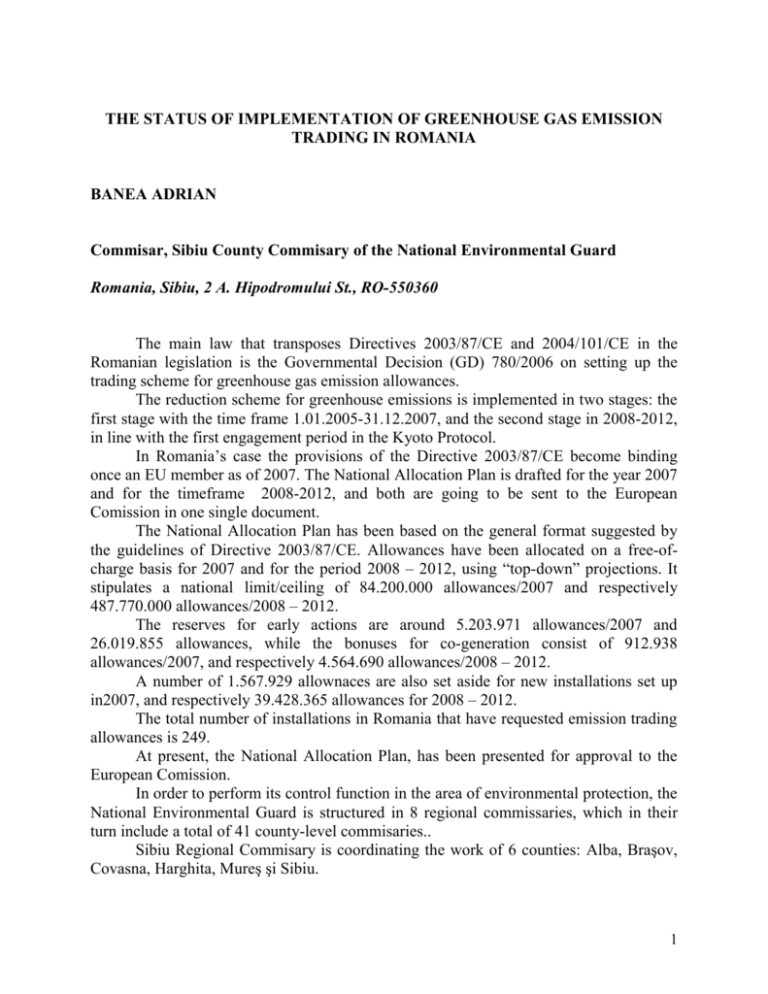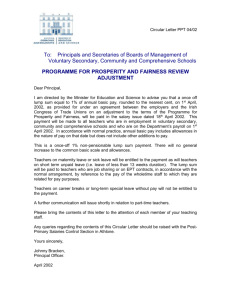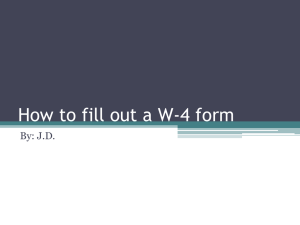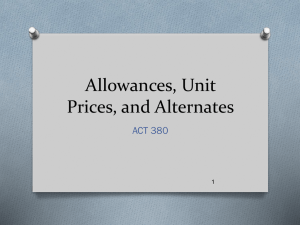The Status Of Implementation Of Greenhouse Gas Emission
advertisement

THE STATUS OF IMPLEMENTATION OF GREENHOUSE GAS EMISSION TRADING IN ROMANIA BANEA ADRIAN Commisar, Sibiu County Commisary of the National Environmental Guard Romania, Sibiu, 2 A. Hipodromului St., RO-550360 The main law that transposes Directives 2003/87/CE and 2004/101/CE in the Romanian legislation is the Governmental Decision (GD) 780/2006 on setting up the trading scheme for greenhouse gas emission allowances. The reduction scheme for greenhouse emissions is implemented in two stages: the first stage with the time frame 1.01.2005-31.12.2007, and the second stage in 2008-2012, in line with the first engagement period in the Kyoto Protocol. In Romania’s case the provisions of the Directive 2003/87/CE become binding once an EU member as of 2007. The National Allocation Plan is drafted for the year 2007 and for the timeframe 2008-2012, and both are going to be sent to the European Comission in one single document. The National Allocation Plan has been based on the general format suggested by the guidelines of Directive 2003/87/CE. Allowances have been allocated on a free-ofcharge basis for 2007 and for the period 2008 – 2012, using “top-down” projections. It stipulates a national limit/ceiling of 84.200.000 allowances/2007 and respectively 487.770.000 allowances/2008 – 2012. The reserves for early actions are around 5.203.971 allowances/2007 and 26.019.855 allowances, while the bonuses for co-generation consist of 912.938 allowances/2007, and respectively 4.564.690 allowances/2008 – 2012. A number of 1.567.929 allownaces are also set aside for new installations set up in2007, and respectively 39.428.365 allowances for 2008 – 2012. The total number of installations in Romania that have requested emission trading allowances is 249. At present, the National Allocation Plan, has been presented for approval to the European Comission. In order to perform its control function in the area of environmental protection, the National Environmental Guard is structured in 8 regional commissaries, which in their turn include a total of 41 county-level commisaries.. Sibiu Regional Commisary is coordinating the work of 6 counties: Alba, Braşov, Covasna, Harghita, Mureş şi Sibiu. 1 Through the “top-down” projection method, the region was allocated a total number of 5.325.972 allowances for 2007 (which represents 6,32% of the national ceiling of 84.200.000 allowances for 2007), and respectively a number of 29.280.580 allowances for 2008-2012 (which represents 6% of the national ceiling of 487.770.000 allowances for 2008 – 2012). The allowances were distributed free of charge between the 42 enterprises, who work in the following fields: Type of installation Activities in the field of energy Production of cast iron and steel Production of limestone and cement Glass production Production of roof tiles and bricks Production of paper and cardboard No. o operators 22 operators 5 operators 3 operators 4 operators 6 operators 2 operators No. of allowances received 3.531.599 124.088 1.406.298 102.661 117.733 36.149 Of these, 30 enterprises fall under the Directive 96/61/CE regarding IPPC and all have obtained an IPPC permit. The distribution of allowances between sectors is shown in the chart bellow.: Distribution of allowances between sectors 67% 2% Energy Ferrous metal Limestone and cement Glass production Rooftiles and bricks Paper and cardboard 26% 1% 2% 2% 2 The two counties where no allowances have been granted (Covasna şi Harghita), have a weaker economic development, with light and wood production industries and no installation that falls under Directive 2003/87/CE regarding the greenhouse gass emissions. In the region there are 2 operators that use biomass in burning processes, and therefore they are not subject to the Directive. Regarding bonuses for co-generation, only 2 installations in the region have obtained such allowances: SC Enercompa SRL Sibiu (3415 allowances/2007), and respectively SC Azomures SA Târgu Mureş (16281 allowances for 2007). At the same time, one of the operators that have initially requested an allowance will not longer fall under the GD 780/2006, due to an error in evaluating the capacity of the furnaces they use for the production of ceramics products (and will no longer fall under IPPC) . 3







